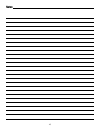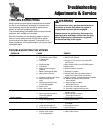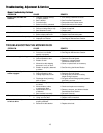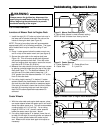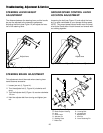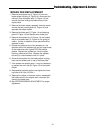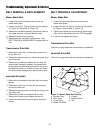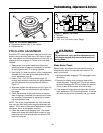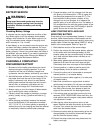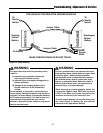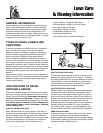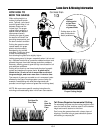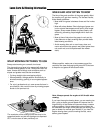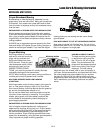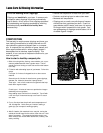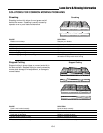
BATTERY SERVICE
Checking Battery Voltage
A voltmeter can be used to determine condition of bat-
tery. When engine is off, the voltmeter shows battery
voltage, which should be 12 volts. When engine is run-
ning, the voltmeter shows voltage of charging circuit
which normally is 13 to 14 volts.
A dead battery or one too weak to start the engine may
not mean the battery needs to be replaced. For exam-
ple, it may mean that the alternator is not charging the
battery properly. If there is any doubt about the cause of
the problem, see your dealer. If you need to replace the
battery, follow the steps under Cleaning the Battery &
Cables in the Regular Maintenance Section.
CHARGING A COMPLETELY
DISCHARGED BATTERY
1. Be aware of all the safety precautions you should
observe during the charging operation. If you are
unfamiliar with the use of a battery charger and
hydrometer, have the battery serviced by your dealer.
2. Add distilled water sufficient to cover the plate (fill to
the proper level near the end of the charge). If the
battery is extremely cold, allow it to warm before
adding water because the water level will rise as it
warms. Also, an extremely cold battery will not
accept a normal charge until it becomes warm.
3. Always unplug or turn the charger off before attach-
ing or removing the clamp connections.
4. Carefully attach the clamps to the battery in proper
polarity (usually red to [+] positive and black to [-]
negative).
5. While charging, periodically measure the tempera-
ture of the electrolyte. If the temperature exceeds
125° F (51.6° C), or if violent gassing or spewing of
electrolyte occurs, the charging rate must be reduced
or temporarily halted to prevent battery damage.
WARNING
Keep open flames and sparks away from the
battery; the gasses coming from it are highly
explosive. Ventilate the battery well during
charging.
6. Charge the battery until fully charged (until the spe-
cific gravity of the electrolyte is 1.250 or higher and
the electrolyte temperature is at least 60° F). The
best method of making certain a battery is fully
charged, but not over charged, is to measure the
specific gravity of a cell once per hour. The battery is
fully charged when the cells are gassing freely at low
charging rate and less than 0.003 change in specific
gravity occurs over a three hour period.
JUMP STARTING WITH AUXILIARY
(BOOSTER) BATTERY
Jump starting is not recommended. However, if it must
be done, follow these directions. Both booster and dis-
charged batteries should be treated carefully when using
jumper cables. Follow the steps below EXACTLY, being
careful not to cause sparks. Refer to Figure 43 .
1. Both batteries must be of the same voltage.
2. Position the vehicle with the booster battery adjacent
to the vehicle with the discharged battery so that
booster cables can be connected easily to the batter-
ies in both vehicles. Make certain vehicles do not
touch each other.
3. Wear safety glasses and shield eyes and face from
batteries at all times. Be sure vent caps are tight.
Place damp cloth over vent caps on both batteries.
4. Connect positive (+) cable to positive post of dis-
charged battery (wired to starter or solenoid).
5. Connect the other end of same cable to same post
marked positive (+) on booster battery.
6. Connect the second cable negative (-) to other post
of booster battery.
7. Make final connection on engine block of stalled
vehicle away from battery. Do not lean over batteries.
8. Start the engine of the vehicle with the booster bat-
tery. Wait a few minutes, then attempt to start the
engine of the vehicle with the discharged battery.
9. If the vehicle does not start after cranking for thirty
seconds, STOP PROCEDURE. More than thirty sec-
onds seldom starts the engine unless some mechan-
ical adjustment is made.
10. After starting, allow the engine to return to idle
speed. Remove the cable connection at the engine
or frame. Then remove the other end of the same
cable from the booster battery.
11. Remove the other cable by disconnecting at the dis-
charged battery first and then disconnect the oppo-
site end from the booster battery.
12. Discard the damp cloths that were placed over the
battery vent caps.
Troubleshooting, Adjustment & Service
24



